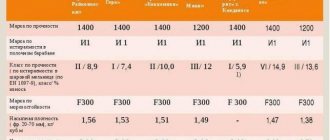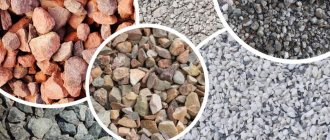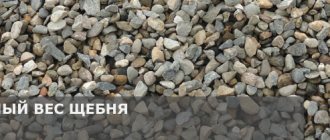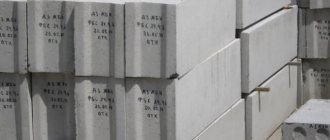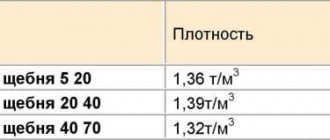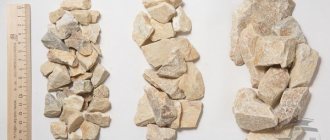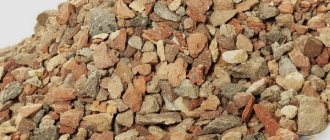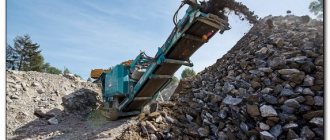The grade of crushed stone in the vast majority of requests from potential customers implies the strength of crushed stone
of this variety. The magnitude of the tensile strength is determined experimentally during the compression of a sample batch of building materials in a special cylinder, through which the crushability of crushed stone under the pressure of an asphalt paving roller on roads is simulated.
Marking of crushed stone
in terms of strength, it is carried out by the letter index “M” and a numerical value from 200 to 1400, characterizing the tensile strength of the building material in kg/cm².
Thus, M200 crushed stone , while granite crushed stone
(
strength 1400 ... 800 kg/cm² - depending on the location of extraction and fraction).
Strength
Strength is a characteristic (grade) that means the resistance of a material to mechanical stress.
The strength of crushed stone is indicated by the letter “M” and a number. The figure is not the impact on crushed stone in kilograms, as is often (and erroneously) indicated in many sources. Assigning an indicator is more complicated. To determine the strength of a material, a mechanical (crushing) effect is applied to it in a cylinder.
The force of impact depends on the diameter of such a device. So, for a cylinder with a diameter of 75 mm, the force is 5,000 kg per second. For a device with a diameter of 150 mm, the impact force is 20,000 kg per second. Next, the percentage of mass loss of crushed stone after crushing is determined. In turn, this percentage and the values permissible by GOSTs indicate that the material belongs to a specific brand in terms of strength.
The following strength grades are available:
- M200
- M300
- M400
- M600
- M800
- M1000
- M1200
- M1400
In turn, brands are divided into the following groups:
- High strength (M1200-1400)
- Durable (M800-1200)
- Medium strength (M600-800)
- Weak strength (M300-600)
- Very weak strength (M200)
Simply put, low-strength crushed stone will turn into dust if a caterpillar tractor drives over it, but high-strength crushed stone will not lose its properties. Therefore, this characteristic is important for construction, road, industrial and engineering work.
There are works in which the strength of crushed stone is not particularly important. First of all, this concerns the use of the material in landscape design (decorating flower beds, designing an alpine slide). A striking example here is marble crushed stone. Its strength characteristics are average; the rock index in the Sverdlovsk region is M600. But since its main sphere is decorative, they buy it based on other qualities.
Classification of crushed stone by origin
Granite crushed stone
Characteristics
The quality of the material is superior to all analogues. Its adhesion to the binder is higher due to the rough surface and sharp edges. Concrete structures are the strongest and most durable compared to other types of rock type materials.
Application
Depending on the type of building crushed stone, it is part of concrete and asphalt and is suitable for the construction of foundations, building and bridge structures, and airfield pavements. It is in demand for laying roads and tram lines. Fine grain is used to sprinkle paths, sports and children's playgrounds, decorate gardening areas, and line building structures.
From us you can buy crushed stone in Tyumen with delivery throughout the city.
Brands of granite crushed stone:
- M1200-1400 is a heavy-duty type that is suitable for most jobs;
- M800-1200 - durable for the production of reinforced concrete structures and construction work;
- M600-800 - average strength, example of use - roads with low load;
- M300-600 - strength is below average, which is why the material is suitable for the construction of embankments and paths in summer cottages;
- M200 - minimum strength suitable for low-load sidewalks and landscape design.
Limestone crushed stone
Application
The material is widely used due to the prevalence of the breed and ease of processing, as well as high quality indicators. It is used in road construction as a cushion for covering, and as a filler in the production of concrete and asphalt. They are used on secondary roads with low traffic capacity.
Crushed limestone of different fractions is in great demand as decoration. They sprinkle it on sports and children's playgrounds, park areas, paths, banks of reservoirs, and decorate the local area.
What are the crushed stone fractions:
- 5–20 mm - fine grinding is used for concrete mixtures and small reinforced concrete structures;
- Crushed stone 20–40 mm - the most popular medium grind is suitable for pouring foundations, reinforced concrete products, building roads with heavy traffic, and sprinkling paths;
- 40–70 mm is a coarse grind that is rarely used, mainly to create gravel pads and a drainage layer.
Brands of crushed limestone
The material is divided into grades from M300 to M600. The lower the grade, the more it crumbles. For example, M300 does not meet most of the requirements of the technical specifications of construction projects and is suitable for backfilling. Other brands are more in demand and are suitable for most construction work.
crushed gravel
Application
The advantages of the material are its high frost resistance F200 and low radioactive background, as well as a lower price compared to granite. Depending on the grade and fraction of crushed stone, it is suitable for reinforcing foundations, filling and reconstructing roads without hard surfaces, pedestrian paths, and constructing railway embankments. The high decorative properties of the material allow it to be used in landscape design and for finishing building structures.
Crushed gravel grades based on crushability strength:
- high-strength M1200;
- durable M1000;
- medium M800;
- weak M600.
Frost resistance
Frost resistance is an indicator (grade) that tells how many times crushed stone can survive freezing and thawing without losing its quality properties. It is designated by the letter “F” and a number. The number is nothing more than the number of freeze-thaw cycles.
It is worth immediately clarifying that one cycle is not equal to one season. Indeed, in a temperate climate, the weather can change from plus to minus several times a month. Each such significant temperature difference is a cycle.
The following frost resistance grades exist:
- F15
- F25
- F50
- F100
- F150
- F200
- F300
- F400
The higher this indicator, the longer the material and products made from it will last you. For example, crushed stone with the F50 grade will withstand 50 freeze-thaw cycles. If you try to translate this figure into time for, say, a temperate climate, you get something between 10 and 30 years (again, depending on the number of large temperature changes).
We would like to focus your attention on the following: the frost resistance grade shows how many cycles crushed stone can withstand without loss of quality characteristics. But this does not mean that after, for example, 50 such cycles, the stones will suddenly begin to collapse and crumble, no. There is only a possibility that after this time the characteristics of the crushed stone will decrease slightly. It can be safely used further.
In the Sverdlovsk region, preference is given to higher grades of crushed stone in terms of frost resistance. This is due to the fact that the climate in our region is temperate, and several freeze-thaw cycles can occur in one season.
Water resistance
Water is a universal solvent; it also affects rocks. But material of igneous origin dissolves very slowly. Hundreds and even thousands of years pass until the stone is destroyed.
Granite crushed stone belongs to the water resistance grade B1. This means that after keeping in water for 24 hours, its mass decreases by less than 1%. From such material it is possible to build dams and dams, underwater bridge structures. There is no risk that after a few decades the strength of the stone will decrease due to partial dissolution.
Flakiness
It determines the number of flat and needle-shaped particles in the total mass of crushed stone. They are also called irregularly shaped grains. The more such particles, the more voids there will be between the grains when compacting the material. This indicator is very important for the construction of road foundations.
The shape of the grains is determined by their width and thickness.
Based on the percentage of lamellar or needle grains, five groups are distinguished:
- Group I (cuboid)
- Group II (improved)
- Group III (normal)
- IV group (regular)
- Group V (regular)
Now let's look at each one separately.
Group I (cuboid)
The content of irregularly shaped grains here is up to 10%. This is the group with the best performance in this classification.
Cuboid products are used for the production of reinforced concrete products, as well as concrete that requires the highest performance characteristics (for example, for the construction of skyscrapers, dams, bridges, power units for nuclear power plants).
Group II (improved)
The content of flat and needle-shaped grains here is from 10% to 15%.
Crushed stone of this group is the most common in our region. Its performance characteristics are quite high, which allows it to be used in various fields of construction (read more in the article Crushed stone for construction work) and the production of concrete, asphalt, reinforced concrete products (read more in the articles Crushed stone for concrete, Crushed stone for asphalt).
Group III (normal)
Grain content – from 15% to 25%.
Materials of this group can also be used as a filler in concrete. But we must remember that a high content of irregularly shaped grains does not provide good adhesion and increases cement consumption. When constructing a road surface, such material, due to the resulting voids, is difficult to compact. Therefore, it can only be used on the lower layers, followed by declinching with crushed stone of a higher flaky group. Without restrictions, the material of this group can only be used for filling sites.
IV group (regular)
The content of flaky grains is from 25% to 35% of the total mass.
Materials of the 4th flakiness group are used for backfilling, construction of temporary road surfaces and lower layers of dirt roads (read more in the article Crushed stone for dirt roads).
Group V (regular)
Grain content – from 35% to 50%.
The products of this group are intended for construction of belt roads and sites along which construction equipment will move.
Application
Crushed gravel has found wide application in many areas, including the following:
- Production of sleepers from reinforced concrete, as well as other structures from this material;
- Soil drainage;
- Concrete production;
- Floor slabs;
- Road construction;
- Artistic concrete casting;
- As a leveling material for other monolithic backfills;
- For landscape design and garden paths;
- Construction of bridges and other massive structures.
The rock can also be used as a bulk layer on railways, at airports, as well as during the construction of radioactive structures. In the latter case, the use of crushed gravel is strongly recommended, since it has very low radioactivity.
Which crushed stone is best for the cushion and foundation of a house depends on the features and height of the future building. In most cases, crushed gravel is used for cushioning and preparing concrete.
Adhesion
Adhesion is the ability of a material to adhere to bituminous binders. Many available sources indicate a direct relationship between adhesion and the color of crushed stone, but this opinion is erroneous. The degree of adhesion can be indicated by such a characteristic of crushed stone as flakiness. Crushed stone with the lowest content of irregularly shaped grains has better adhesion.
Another indicator that plays an important role for this characteristic is the structure and composition of the rock from which the crushed stone is made. Stones with a rough surface (eg granite) will have better adhesion compared to smooth ones (eg limestone). It is also necessary to mention that washed crushed stone has better adhesion than crushed stone in its natural state.
The exact indicator of crushed stone adhesion can only be determined in laboratory conditions.
Classification of crushed stone by fractions
The smallest fraction, up to 5 mm
consists of crushed stone screenings. It is used for filling sports and children's playgrounds, reinforced concrete structures, sprinkling roads and sidewalks against ice, and creating landscapes in gardening and park farming.
Small fractions have sizes of 3x8, 5x10, 5x20, 10x20 mm
. It is in demand among construction organizations for the production of concrete, construction of foundations, creation of road and airfield surfaces, and bridge structures.
Crushed stone of medium fraction 20x40mm
suitable for the production of concrete and reinforced concrete products, construction of railways and highways, foundations and buildings, filling roads and parking lots.
Large fraction 25x60, 40x70 mm
suitable for the manufacture of concrete and massive structures where large volumes of this material are used. Suitable for building railway tracks and creating drainage.
Rubble stone 40x200 mm
consists of rock fragments and is suitable for the construction of retaining walls, foundations or fences, decoration of reservoirs and swimming pools.
Non-metallic building materials:
- Delivery of crushed stone
- Concrete delivery
- Sand delivery
Water absorption
Water absorption refers to the ability of a material to absorb and retain moisture. And, it seems, what does this indicator have to do with stones? And here it is. After all, crushed stone has pores and microcracks that are not visible to the naked eye. Water may accumulate in them. In summer, its content in cracks will not affect the quality of the material in any way, but in winter, moisture turns into ice, expanding and destroying stones from the inside.
All types of crushed stone we offer for sale are moisture resistant, since their water absorption coefficient does not exceed 0.8. But, despite the relatively low performance (compared to other building materials), they must be taken into account when designing.
Water absorption affects the change in material mass and strength properties. In addition, as we have already said, when freezing, the material can increase in volume (due to the conversion of moisture into ice).
Extraction of crushed gravel in quarries
Crushed gravel is mined along with other types of stones in loose sedimentary rock. Since it is initially a monolithic rock, blasting work will be required.
When specialists carry out a series of explosions, the rubble will split into relatively small blocks. Next, they are placed in special crushing equipment, which allows the stone to be crushed into the required fractions.
Once the crushed stone is crushed, it is sifted. This is done using the screening method, which allows you to separate smaller rocks from larger ones. Almost immediately it can be used for various purposes, including construction.
Water resistance
The moisture resistance of crushed stone is an indicator indicating the percentage of mass loss of the material when going through the water saturation/drying cycle.
State standards establish the following moisture resistance grades:
- B1 (weight loss up to 1%)
- B2 (weight loss from 1% to 3%)
- B3 (weight loss over 3%)
Brand B1 is assigned to:
- Crushed stone from igneous or metamorphic rocks with a strength of more than M600
- Crushed stone from sedimentary rocks with a strength of over M400
For other types of material, tests must be carried out in a special laboratory. If, according to the test results, the weight loss was less than 1%, the crushed stone is assigned grade B1.
In all other cases, it is assigned brands B2 or B3. This material has significant limitations in its use. It can be used in constructing temporary roads (read more in the article Crushed stone for dirt roads), filling holes, ditches - that is, in those works where durability and reliability are not required from it.
Definition
The grade of crushed stone means the minimum strength of the rock. It directly depends on the characteristics of the underlying array. In addition to strength, the indicator hides the ability to withstand the number of freeze-thaw cycles, as well as abrasion. These quantities are not always related to each other.
The grades of crushed stone are given in GOST 8267-93 “Crushed stone and gravel from dense rocks for construction work.” It also contains standardization of material by fraction, flakiness, density and radioactivity and detailed technical characteristics.
Content of dust and clay particles
Dust and clay particles are considered inclusions whose size does not exceed 0.05 mm. And this indicator indicates the percentage of such particles in crushed stone.
The valid values here are:
- For igneous and metamorphic rocks - up to 1%
- For sedimentary rocks - from 2 to 3% (depending on the strength grade)
- For crushed gravel – from 1 to 3% (depending on the strength grade)
Dust and clay particles (or, more simply, dust) reduce the ability of crushed stone to adhere. In this regard, materials with a high percentage of such inclusions cannot be used for the construction of asphalt roads and as a filler in concrete. It should also be taken into account that dust and clay particles tend to swell upon contact with water. And this ability can affect the change in the mass of crushed stone.
general information
Crushed gravel is classified as a nonmetallic type of stone; it is inorganic and has a more rounded surface, unlike, for example, granite.
The material is considered very environmentally friendly, although it is still inferior in strength to crushed gravel. But its price is lower, provided that other indicators remain high. This is precisely what determines the use of this breed in the construction of a large number of objects.
A little more about what crushed stone is in the video:
Content of weak rock grains
The raw materials that are crushed into crushed stone are heterogeneous, and particles with less strength may be found in the rock. Usually their percentage is small, but it is definitely worth taking into account. Therefore, in addition to the strength indicator, the percentage of weak rock grains is also determined for crushed stone.
As a rule, weak grains are broken when struck with a hammer or even by hand. Therefore, you should take this indicator into account when choosing a material and do not buy crushed stone that crumbles in your hands.
Acceptable values for this indicator:
- Crushed stone with strength from M1000 to M1400 - up to 5%
- Crushed stone with strength from M400 to M800 - up to 10%
- Crushed stone with strength from M300 - up to 15%
Abrasion of crushed stone
The abrasion grade of crushed stone is determined in a laboratory in a test drum. The batch is loaded into the receiver, the circle is started at a certain speed for some time. The weight loss of the core stone mass is then measured. Based on the result, the stone is assigned a group:
| Wear resistance grade (group) | Weight loss during testing,% |
| I – I | Up to 25 |
| I – II | 25…35 |
| I – III | 35…45 |
| I – IV | 45…60 |
The degree of wear is important when choosing crushed stone for road construction. The higher it is, the better.
Bulk density
Bulk density of crushed stone is a parameter indicating the ratio of weight and volume. Simply put, it shows what weight of crushed stone (without additional compaction) fits into a container with a volume of 1m3. If you know this indicator, you can easily convert the volume of material into weight and vice versa.
The value of this indicator is called the bulk density coefficient of crushed stone, the unit of measurement of which is kilogram per cubic meter (kg/m3) or ton per cubic meter (t/m3).
In practice, this indicator is measured as follows:
A container equal to 1 m3 is filled with crushed stone and weighed. Let's assume the net mass of the material is 1300 kg. This means that the bulk density coefficient is 1300 kg/m3 or 1.3 t/m3.
A specific value is not static. Of course, there is a certain relationship between types of crushed stone and bulk density, but the exact value is determined only during laboratory tests.
Information on bulk density is contained in the certificate or passport for a specific batch of goods. Tables of coefficients, of which there are a large number on the Internet, are of an informational nature and often do not correspond to reality at all. This is due to the fact that bulk density is an individual indicator for each type and fraction of crushed stone. It is very rare that two seemingly similar materials with similar characteristics have the same bulk density.
Some nuances:
- Crushed stone with a coefficient from 1300 kg/m3 to 1400 kg/m3 will be good and of high quality.
- If the value is above 1400 kg/m3, then such a material has super properties or characteristics that are at the limits of the maximum possible.
- And crushed stone with a bulk density below 1300 kg/m3, as a rule, will be of poor quality. Before purchasing and using such material, it is worth studying its other characteristics in detail.
Read more about this property on the page Bulk density of bulk materials. If you want to get an idea of the bulk density of all types of crushed stone that we offer for sale, we recommend reading the page Bulk density of crushed stone (comparative characteristics).
Advantages and disadvantages
This type of material has both negative and positive sides. The first is that its strength is lower than that of crushed granite.
However, there will still be more advantages, since crushed gravel has both an affordable price and other very outstanding characteristics. This includes resistance to radiation, breadth of application, and environmental friendliness.
Based on all the information about crushed gravel, the material can be given the following ratings:
- Price - 5 points. It is much more affordable than its granite counterpart, while maintaining fairly high performance;
- Practicality - 5 points. The use of this material is possible in many areas, from concrete production to the construction of structures;
- Appearance - 4 points. Both wide and small fractions of the rock are widely used for decorative purposes;
- Ease of manufacture - 4 points. It is, of course, impossible to extract it yourself, but quarry mining is a rather complex process;
- Labor intensity when using - 5 points. Does not require any additional processing and can be used immediately after purchase;
- Environmental friendliness - 5 points. It has no harmful impurities, and the origin of the material is completely natural.
